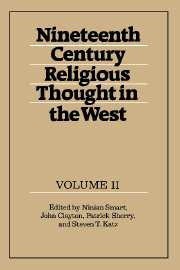Book contents
- Frontmatter
- Contents
- 1 SAMUEL TAYLOR COLERIDGE
- 2 RALPH WALDO EMERSON AND THE AMERICAN TRANSCENDENTALISTS
- 3 JOHN HENRY NEWMAN AND THE TRACTARIAN MOVEMENT
- 4 DREY, MÖHLER AND THE CATHOLIC SCHOOL OF TÜBINGEN
- 5 ROMAN CATHOLIC MODERNISM
- 6 RUSSIAN RELIGIOUS THOUGHT
- 7 BRITISH AGNOSTICISM
- 8 THE BRITISH IDEALISTS
- 9 WILLIAM JAMES AND JOSIAH ROYCE
- INDEX
5 - ROMAN CATHOLIC MODERNISM
Published online by Cambridge University Press: 06 January 2010
- Frontmatter
- Contents
- 1 SAMUEL TAYLOR COLERIDGE
- 2 RALPH WALDO EMERSON AND THE AMERICAN TRANSCENDENTALISTS
- 3 JOHN HENRY NEWMAN AND THE TRACTARIAN MOVEMENT
- 4 DREY, MÖHLER AND THE CATHOLIC SCHOOL OF TÜBINGEN
- 5 ROMAN CATHOLIC MODERNISM
- 6 RUSSIAN RELIGIOUS THOUGHT
- 7 BRITISH AGNOSTICISM
- 8 THE BRITISH IDEALISTS
- 9 WILLIAM JAMES AND JOSIAH ROYCE
- INDEX
Summary
Identifying the Movement
The term ‘Catholic Modernism’ is referred to a movement within the Roman Catholic Church at the turn of the present century the aim of which was to bring traditional Catholic teaching into closer relations with current thought, especially in philosophy, history and social theory. Although the actual word modernism did not come into use until about 1905, and at first only among the movement's opponents, the tendencies so designated may be said to have emerged about 1890 and to have been brought to an end some twenty years later by the imposition of the anti-Modernist oath not only upon teachers in Catholic seminaries and universities but upon all ordinands to the priesthood. Yet if its dating presents little difficulty, many scholars would regard it as misleading if not false to describe it in a way that suggests a clear consistency of interests and purposes and even a measure of organization. To the student of the period it may seem to have possessed no real unity and indeed to be more aptly characterized as a complex of movements, each very largely determined by the personality and pursuits of its leading figure or figures, as also to some extent by its geographical provenance. In any case it was at least twofold, in the sense that although its concern was chiefly theological it was also not without a politico-social aspect, while those who could be regarded as ‘progressives’ in one field were by no means necessarily so in another.
- Type
- Chapter
- Information
- Nineteenth-Century Religious Thought in the West , pp. 141 - 178Publisher: Cambridge University PressPrint publication year: 1985



